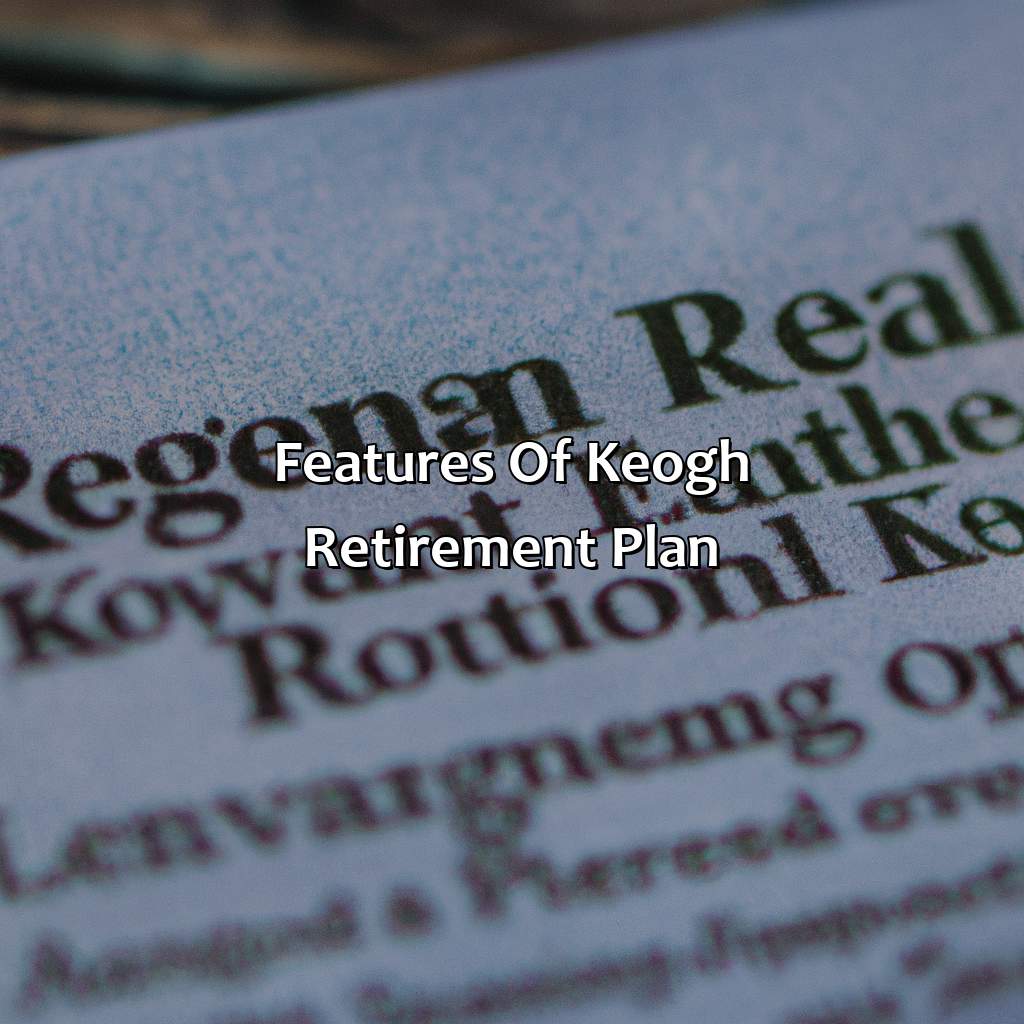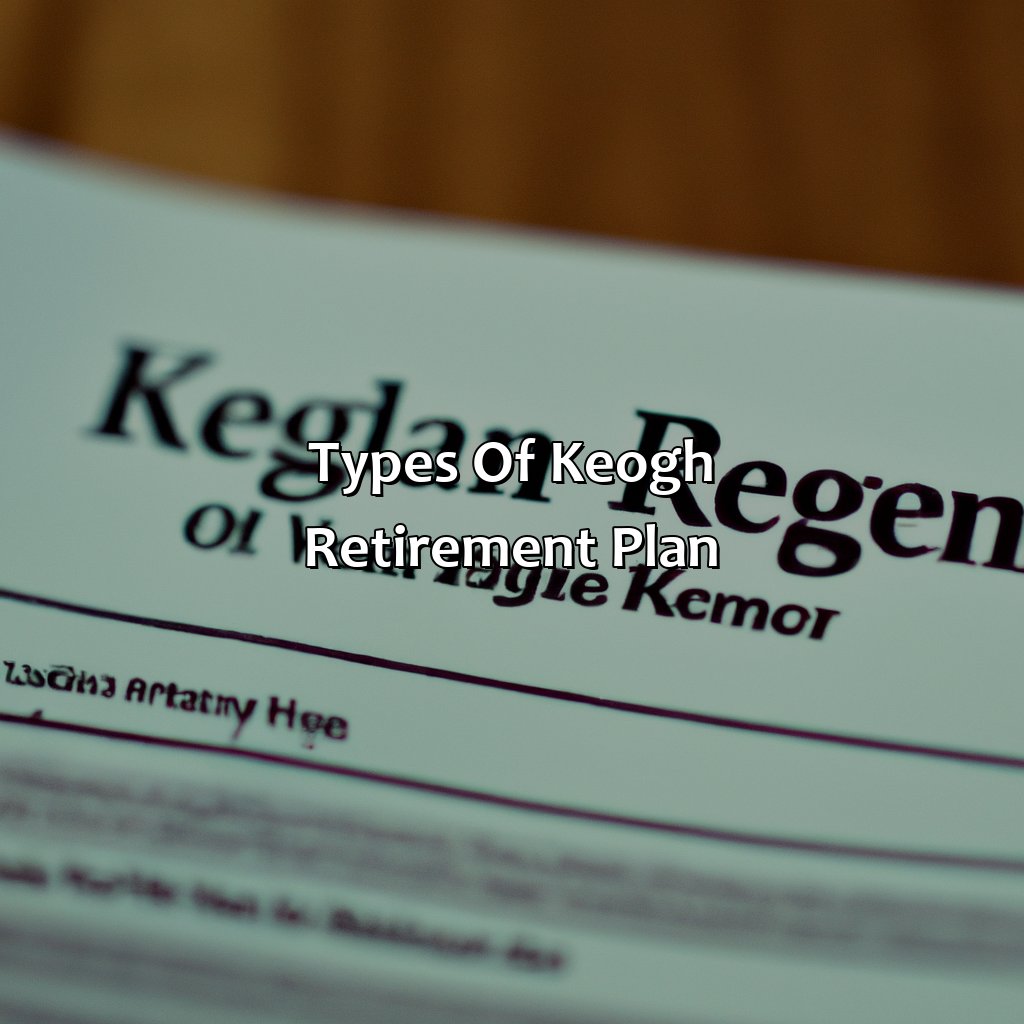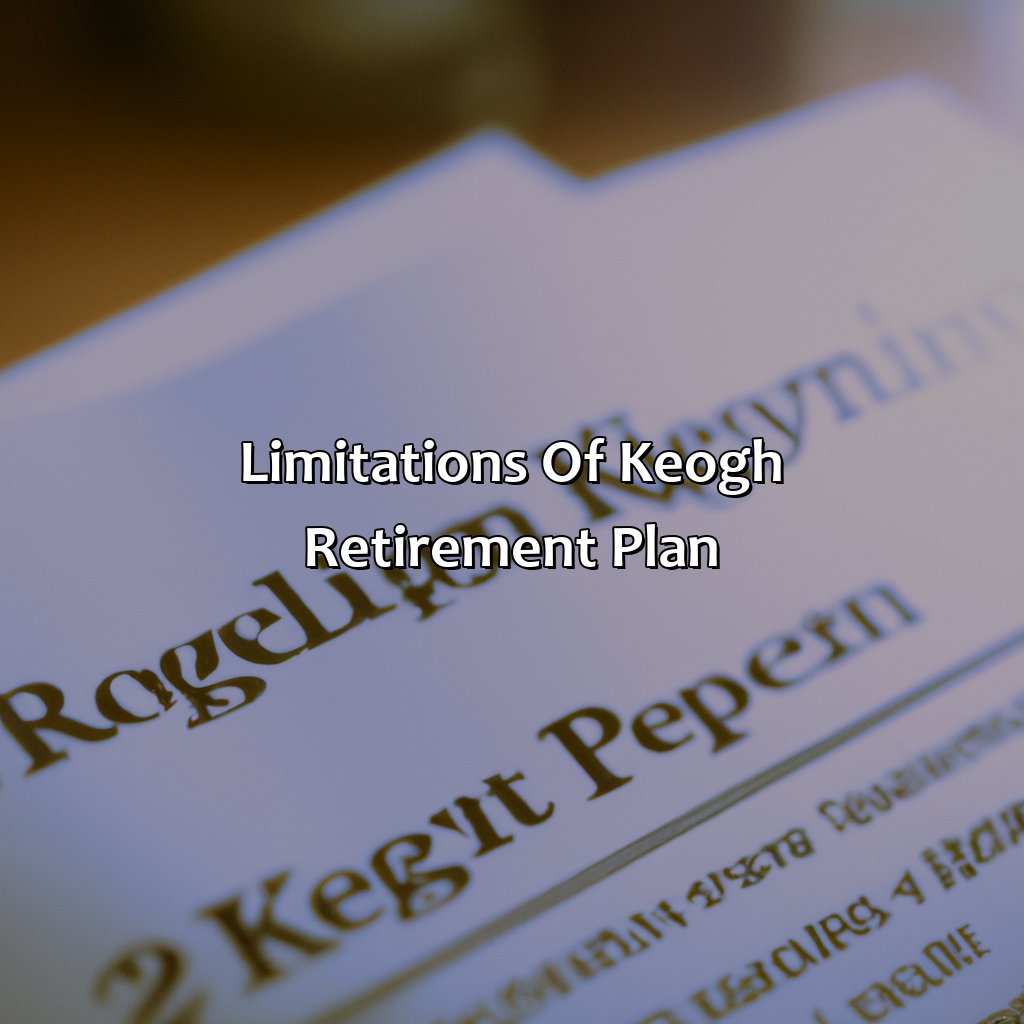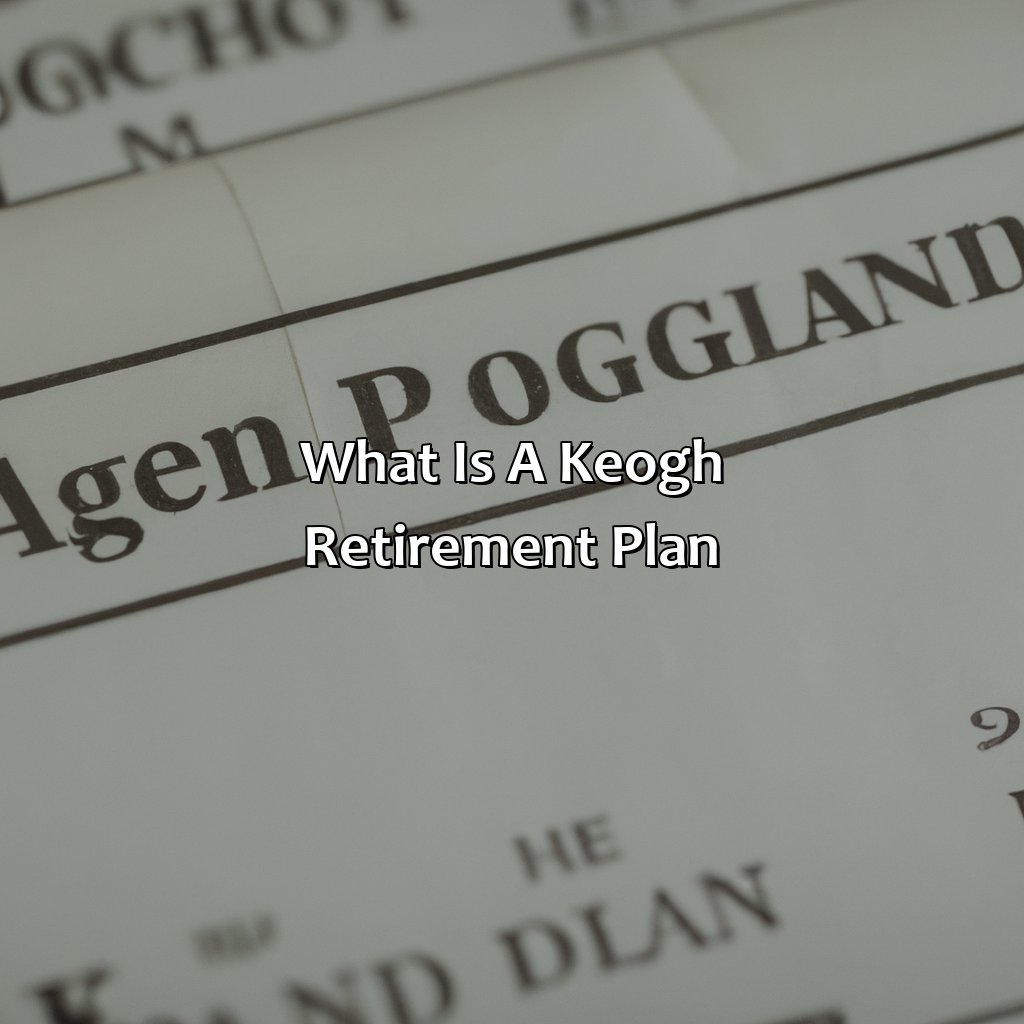What Is A Keogh Retirement Plan?
Key Takeaway:
- A Keogh Retirement Plan is a retirement account designed for self-employed individuals, sole proprietors, and partners of a business.
- The plan offers high annual contribution limits, flexible contribution options, and different investment options such as defined benefit and defined contribution plans.
- Keogh Retirement Plan presents tax deductibility of contributions, tax-deferred growth, and increased potential for retirement savings as advantages.
Are you looking for a retirement plan that offers tax advantages? If so, a Keogh Retirement Plan may be the perfect solution for you. With this plan, you can put away money for your future in a secure and tax-efficient way. Read on to learn more!
What is a Keogh Retirement Plan?
A Keogh Retirement Plan is a tax-deferred retirement account for self-employed individuals or small business owners. It allows them to save for retirement while reducing their taxable income. Contributions to a Keogh plan are made from pre-tax income, and they can be invested in a variety of securities, such as stocks and bonds.
The plan is named after Eugene M. Keogh, a congressman who introduced legislation in 1962 that permitted self-employed individuals to establish their own retirement plans.
Keogh Retirement Plans can be either defined contribution plans, where the contributions are a fixed percentage of income, or defined benefit plans, where the contributions are calculated based on the desired retirement benefit. These plans offer higher contribution limits than traditional IRAs, making them a popular choice among high earners. However, they require more administrative work and expenses than other retirement plans.
It’s important to note that Keogh plans are not available for all types of businesses. For example, partnerships and corporations with more than one owner may not be eligible. It’s best to consult with a financial advisor to determine if a Keogh plan is the right choice for your business.
According to the IRS, the maximum amount that can be contributed to a Keogh plan in 2021 is $58,000, or 25% of your annual income, whichever is less. (Source: IRS.gov)

Image credits: retiregenz.com by Yuval Duncun
Eligibility criteria for Keogh Retirement Plan:
Keogh Retirement Plans are self-employed or small business owner retirement plans. To be eligible for this retirement plan, certain criteria must be met:
- Business must be unincorporated or incorporated as a partnership.
- The owner must be self-employed or a partner in the business.
- The owner must earn income from the business.
- The owner must be at least 21 years old.
Additionally, the contribution limit and deductions for Keogh Retirement Plans depend on various factors such as the business structure, the owner’s age, and the plan’s terms.
It’s important to consider the potential benefits of a Keogh Retirement Plan and ensure eligibility to avoid missing out on potential tax savings and retirement benefits.

Image credits: retiregenz.com by Adam Woodhock
Features of Keogh Retirement Plan:
Features of a Keogh Retirement Plan
A Keogh retirement plan is a qualified, tax-deferred retirement savings plan that helps self-employed individuals and unincorporated business owners save for their retirement. Here are some notable features of this plan:
- Eligibility: Self-employed individuals and unincorporated business owners with no W-2 employees are eligible to contribute to a Keogh plan.
- High Contribution Limits: Contributions to Keogh plans have higher limits than other retirement savings plans, allowing individuals to save more money for their future.
- Employer Contribution Options: Employers can choose to make contributions based on a percentage of the employee’s compensation or a fixed dollar amount.
- Tax Benefits: Contributions made by the employer are tax-deductible as business expenses, while participant contributions are tax-deferred until the time of withdrawal.
- Vesting Rules: The vesting rules may differ based on the type of plan and its rules. Typically, vesting can be immediate or gradually over time.
- Investment Options: Keogh plans offer a wide range of investment options, including stocks, bonds, mutual funds, and more.
It is important to note that Keogh plans have unique details that may vary depending on the type of plan chosen. Some additional plan options include defined benefit, profit-sharing, and money purchase plans. These unique features are essential to consider when selecting a plan that fits your retirement goals.
According to the IRS, as of 2021, the contribution limit for Keogh plans is $58,000 or 25% of earned income, whichever is less. (Source: IRS Publication 560)

Image credits: retiregenz.com by Joel Woodhock
Types of Keogh Retirement Plan:
Keogh retirement plans are savings plans designed for self-employed individuals and business owners to save for their retirement. These plans allow contributions to be made on a pre-tax basis, thus reducing the individual’s taxable income. There are different types of Keogh retirement plans, each with its unique features and contribution limits.
The table below provides an overview of the different types of Keogh Retirement Plan:
| Type of Keogh Retirement Plan | Contribution Limits | Who Can Contribute |
|---|---|---|
| Profit-Sharing Plans | Up to 25% of income | Business owners and employees |
| Defined-Benefit Plans | Contribution Limit based on age and income | Business owners with high income |
| Money Purchase Plans | Up to 25% of income | Business owners and employees |
| Combination Plans | A mix of profit-sharing and defined-benefit components | Business owners and employees |
It is essential to understand the contribution limits and eligibility criteria before deciding on the type of Keogh retirement plan to select. Additionally, specific factors such as age, income, and future retirement plans should be taken into consideration.
To stay financially secure during retirement, it is crucial to start planning and contributing to a Keogh retirement plan as early as possible. Delaying contributions may result in a considerable loss of compound interest over the years. So, don’t miss out on the opportunity to secure your retirement. Start exploring different types of Keogh retirement plans and make a wise decision based on your financial goals and needs.

Image credits: retiregenz.com by Yuval Woodhock
Advantages of Keogh Retirement Plan:
Keogh retirement plans are tax-advantaged retirement savings plans designed for self-employed individuals and small businesses. These plans offer numerous benefits to the plan participant, including tax-deductible contributions, tax-deferred growth, and flexible investment options.
The benefits of Keogh retirement plans include:
- High Contribution Limits: Keogh plans allow higher contribution limits than other retirement plans, which means the plan participant can save more for retirement.
- Tax Deductions: Contributions made to a Keogh plan are tax-deductible, and the money in the plan grows tax-free until withdrawal.
- Flexible Investments: The plan participant can choose from a range of investment options, including stocks, bonds, and mutual funds, to diversify their portfolio and increase potential returns.
Keogh plans have unique features compared to other retirement plans, and some may require consulting with a financial advisor to optimize their benefits. These plans are best suited for self-employed individuals and small businesses with no more than a few employees.
A famous example of the benefits of Keogh plans is the story of retired NBA player Bill Bradley. He contributed to his Keogh plan during his playing career, which allowed him to retire comfortably after basketball.

Image credits: retiregenz.com by Joel Duncun
Limitations of Keogh Retirement Plan:
As a literal meaning of the heading “Limitations of Keogh Retirement Plan,” it can be stated as “Challenges in Investing in a Keogh Retirement Plan.” Although a Keogh Retirement Plan may be a beneficial retirement option for self-employed individuals, there are some drawbacks to consider.
- Restrictions: Keogh Retirement Plans have limited investment options and are subject to strict contribution limits, making it challenging to maximize retirement savings.
- Administrative Tasks: Setting up and administering a Keogh Retirement Plan can be time-consuming and expensive, requiring professional help to comply with complex regulations and tax laws.
- Inflexibility: Once the plan is established, it may not be easy to modify or terminate it, which can be problematic in the case of any changes in business circumstances or life circumstances.
- Funding: Keogh Retirement Plans require steady income to fund, and contribution limits may change, resulting in inadequate retirement savings in the long run.
It is imperative to weigh the benefits and drawbacks before deciding on investing in a Keogh Retirement Plan. Individuals considering this plan should gather as much information as possible and seek professional advice.
One unique aspect is that investors can contribute to Keogh Retirement Plans even if they contribute to other retirement accounts but must comply with contribution limits.
An interesting fact is that the Keogh Retirement Plan is named after Eugene Keogh, a United States Representative from New York, who was the chief sponsor of the bill when it was passed by Congress in 1962.

Image credits: retiregenz.com by James Jones
Five Facts About Keogh Retirement Plans:
- ✅ A Keogh retirement plan is a type of tax-deferred retirement savings plan for self-employed individuals and small business owners. (Source: Investopedia)
- ✅ Unlike other retirement plans, Keogh plans allow for higher annual contributions and tax benefits. (Source: The Balance)
- ✅ Keogh plans can be set up as defined benefit or defined contribution plans, with different requirements and features for each. (Source: IRS)
- ✅ Keogh plans have mandatory distribution requirements starting at age 70 and a half. (Source: Fidelity)
- ✅ Keogh plans were named after Eugene Keogh, a U.S. Representative from New York who sponsored the legislation that created them in 1962. (Source: CNBC)
FAQs about What Is A Keogh Retirement Plan?
What is a Keogh retirement plan?
A Keogh retirement plan, also known as HR-10 plan, is a type of retirement plan designed for self-employed individuals or unincorporated businesses. It is similar to a 401(k) plan and allows individuals to save for retirement on a tax-deferred basis.
Who is eligible for a Keogh retirement plan?
Self-employed individuals or unincorporated businesses are eligible for a Keogh retirement plan. This includes sole proprietors, partnerships, LLCs, and S corporations. However, to be eligible, the business must not have any full-time employees other than the owner and their spouse.
What are the contribution limits for a Keogh retirement plan?
The contribution limits for a Keogh retirement plan depend on the individual’s age and income. For 2021, the maximum contribution allowed is $58,000 or 25% of the earned income, whichever is less. Individuals over the age of 50 can make additional catch-up contributions of up to $6,500.
Are contributions to a Keogh retirement plan tax-deductible?
Yes, the contributions made to a Keogh retirement plan are tax-deductible. This means that individuals can reduce their taxable income by the amount contributed to the plan.
What are the tax implications of a Keogh retirement plan?
Distributions from a Keogh retirement plan are taxable as ordinary income. However, if the plan is set up as a Roth Keogh plan, the contributions are made with after-tax dollars, and the distributions are tax-free.
Can I roll over my Keogh retirement plan to another retirement account?
Yes, a Keogh retirement plan can be rolled over to another retirement account, such as a traditional or Roth IRA or another employer’s retirement plan. However, there may be tax implications, so it’s important to consult with a tax professional before proceeding.








